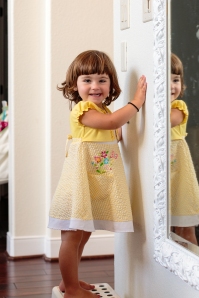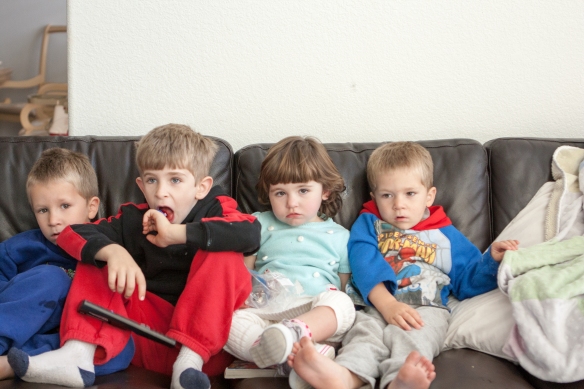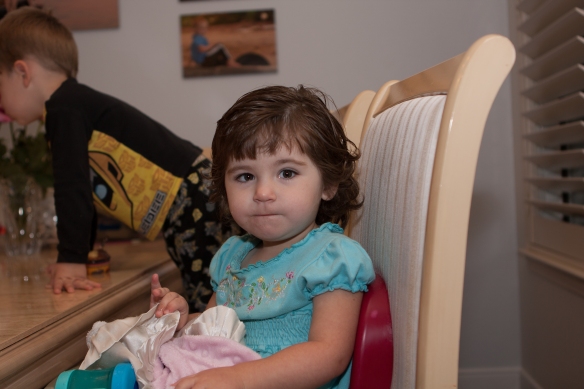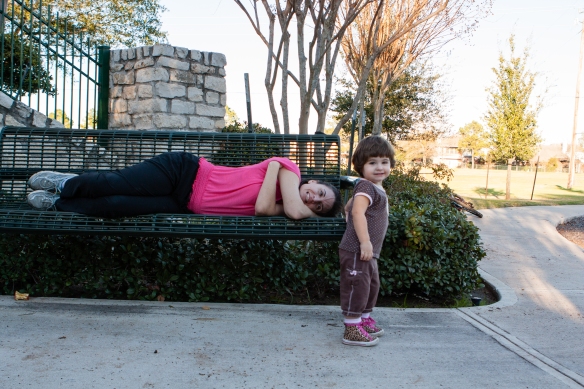Not to diminish the anxiety involved in two kids starting pre-school and one starting first grade, but seriously, it just isn’t that big of a deal for me. Our [neuro-typical] kids are looking forward to going, and this exhausted daddy is too! But, there is some stress related to managing the back-to-school routine. All the stuff to buy. The return of the pain-in-the ass lunch food rules and schedules (is there a hashtag for that?). Lists of rules, that boil down to a rule for every exception (and every exception to the exception) known to mankind regarding public education, when the reverse policy works just fine. Who has to be where and when? I could go on-and-on… but, I really don’t care all that much after all we have been through – I am not stressing (though I may complain from time to time).
Then there is Savanna, (who doesn’t like peanut butter anyway…)
The date is set. The moment has arrived. Not exactly the same acute drama as brain surgery, but definitely high-running emotions about what may result from ABA therapy. Savanna starts September 1. This therapy is widely considered the best intervention for ASD related behaviors.
It is not scientifically proven to ‘work’ (meaning cure) but evidence shows children who go through this type of intervention have the best outcomes.
This means everything is changing. Schedules, therapists, daily routines. Much like for any family with school-age children.
Savanna will also receive OT and ST at their facility, which means discontinuing her current regimen. It means adjustment to entire new set of therapists.
Early Childhood Intervention (ECI) will end on her birthday in September, but her attendance schedule at ABA, effectively ends it day 1 of ABA.
Also discontinuing is vision (VI) and orientation & movement (O&M) through the public school system since Savanna will not enroll in PPCD (Preschool Programs for Children with Disabilities).
I hear quietly from people in the know, this label (qualifying for PPCD) is like jumping into a pit of quicksand. It is so easy, and honestly, the only option for most. Just do the eval, and then boom! You are enrolled! Except, what is not explained is the process to ‘get out’, or remove the labels segregating her from the mainstream crowd. I see mainstream education as an option for Savanna. I want her to have the opportunity to attend Kinder at her normal time if during the next three years she proves she is ready. If not, then we go another route. Is it just a dream at this moment? Maybe so. But, I am not yet ready to relinquish my dreams for that the epilepsy has most likely stolen. Perhaps over time, my dreams will evolve.
I have been closely involved with her care for more than two years now as a stay at home dad. I have interacted in detail with all the specialists and therapists. I know the insurance nuances well. I am the judge, jury, and executioner when it comes to dealing with her behavior and actions. I am also her safe place most of the time. I am keenly aware of when it is time to just hold her and when it is time to push her away and press the issue. Her current team is in tune with her as well in a similar manner. The new therapists and caregivers are not aware of her subtle signs, and so a new chapter begins.
Suddenly, for about 35 hours a week, I will not care for her directly. Everything is changing.
She is still on the waiting list for the facility closes to us, and close the pre-school (yeah that was planned…) I don’t anticipate enrollment until 2015. Houston traffic sucks BIG time. It is a 2-3 hour driving experience everyday. I should not complain about this, but I am, sorry.
While we enter this season of everything changing, we have also noted changes in everything regarding Savanna’s abilities.
As we have weaned down her [single] medication to half the dose she was taking, we have seen a marked increase in memory, visual acuity, and coordination. Is it medication related? Who knows. It could be her natural developmental progression. I find little scholarly information available about effects in 2-year children on this medication. To me, she seems dramatically quicker to react and respond to me, her siblings, her therapists, and the entire world around her. It has been quite an awakening.
She is using utensils now to eat regularly. She has really taken pride in being able to either stick something with a fork, or place food on a fork/spoon and then eat it. Sometimes she uses the back of her hand to model the utensil. I have caught a few of these moments in stills and very short video clip. Note the response at the end of the video – very appropriate.
Recently, I video taped another OT session with Nikki. Here is a great clip of her with a shape sorter. She finally did it! During the activity she was very engaged. She manipulated the sorter to find the right hole for the shape. We have worked on this activity for nearly a year. I am so happy to see what she accomplished, but at the same time, typical kids learn this in a far shorter amount of time. What should I extrapolate from this reality with regard to her development pace or ultimate outcome? I know some of you are thinking, (Just be happy with who she is today!) Everyone wants the best, the most, for their kids. Savanna is no different from that regard. I dream big for Savanna. But this accomplishment, while a great achievement on its own, is easily interpreted with an ominous uncertainty on my part.
Another example. Coloring. We have worked with Savanna on coloring (scribbling of any type, on anything, with any type of marking device), and only in the last few months has she started to “get it”. She sees her siblings coloring, and wants to participate, but just cannot for reasons related to cognition, visual motor integration, and coordination.
I have never worked with Austin (her twin) on coloring. Again, he sees his siblings coloring, and wants to try. At 2 years old (albeit almost 3), he decided he wanted to color something recently. I instructed him this way (more or less) “The crayons and markers are on the table. Get a coloring book, tear out a page and go to town.” Yes, his 4-year-old brother was there too, but he was engrossed in his own masterpiece. I did not help him at all during this time as I regularly have enough to manage. If he is being quiet and in sight at the table coloring, what can go wrong? (Yeah… that is another blog post altogether!) Savanna colored something in a highly supervised and prompted environment with a therapist. Here is a picture of the two results.
Some would say it is not fair to compare her to a normal kid. Really? This is what happens everyday. Not just by me, but by most who interact with her. What is up, and what is down? Does she need this or that, or not need this or that anymore? I am not trying to over-analyze the situation – don’t take me the wrong way. Simply dismissing my observations and analysis does not equate to an irrelevant or non-existent situation.
Make no mistake: Savanna is excelling. She surpassed my expectations and those of many professionals who met her before she was a year old. It is time for me to change my goals, not just for Savanna, but for me as well.
I look at this final picture and I see a metaphor flash before me of our last [almost] three years with Savanna. As I watch her climb to the top of the slide, I see our life challenged with fear, heartbreak, mourning, anger, rebirth, remaking, extraordinarily complex parenting work, and now, maybe we reached a point of inflection in our lives; she in hers. To ABA we go!
-dad












































